Bibimbap – The Best Korean Dish

Bibimbap: Korean Dish
Have you ever tasted a dish so vibrant that it refreshes your eyes? If not, then you haven’t tried bibimbap yet. Bibimbap is a popular and delicious Korean dish that’s not only tasty but also visually appealing.
Bibimbap: A Memorable Experience
I had always heard about Bibimbap, but I got the chance to taste it for the first time when I visited a busy Korean restaurant in Nashik. As soon as I saw the colorful vegetables, fried egg, and gochujang-filled hot stone bowl, I knew I was in for an amazing experience.
The taste and aroma were incredible. With every bite, I discovered a new flavor. The crunch of the vegetables, the softness of the rice, the creaminess of the egg, and the spiciness of the gochujang all came together to create a delightful blend.
With each bite, I felt a sense of satisfaction and happiness. It wasn’t just a meal; it was an experience, a journey through Korean cuisine.
Since that day, Bibimbap holds a special place in my heart. It’s a dish I want to share with others and a memory that will always stay with me.
What is Bibimbap?
Bibimbap is derived from two Korean words: ‘bibim’ (mixing) and ‘bap’ (rice). As the name suggests, it is a dish where various vegetables, meat (or tofu), a fried egg, and rice are mixed together. It’s often served in a hot stone bowl, which enhances its flavor even more.
The History of Bibimbap
The history of bibimbap is ancient. It’s believed to have originated as a simple meal for Korean farmers. They would gather fresh vegetables from their fields and mix them with rice. Over time, the dish evolved with the addition of various spices and ingredients, becoming a national delicacy.
Ingredients Required to Make Bibimbap
- Rice: Short-grain rice is the best as it’s sticky and binds all the ingredients well.
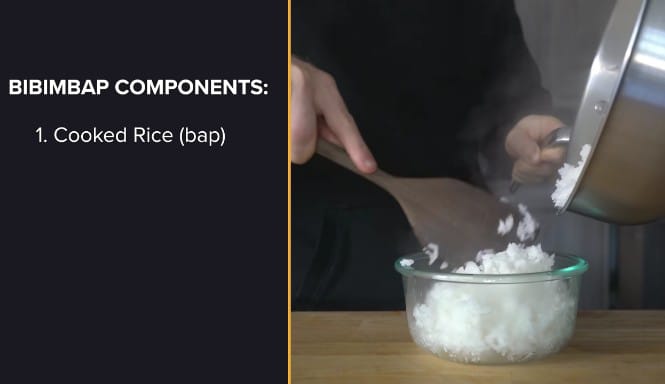
- Vegetables: You can use any vegetables of your choice like carrots, cucumber, beans, cabbage, mushrooms, spinach, etc.
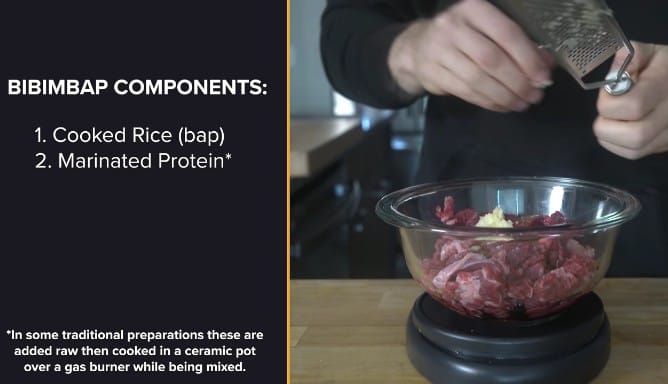
- Protein: You can use beef, chicken, or tofu. Vegetarians can opt for tofu.
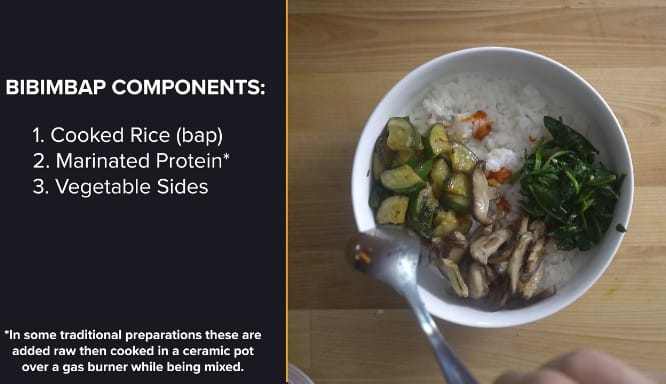
- Gochujang Sauce: This Korean chili paste gives bibimbap its red color and spicy flavor.
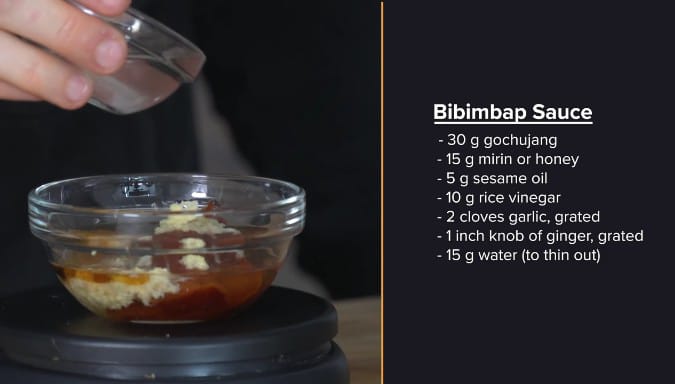
- Egg: A fresh egg.
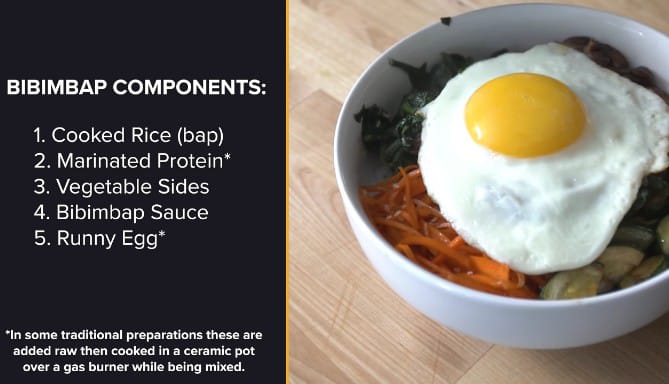
- Sesame Oil: Adds an amazing aroma to the dish.
- Kimchi: A fermented cabbage dish that adds a tangy flavor (optional).
- Noodles: You can add noodles if you like.
How to Make Bibimbap
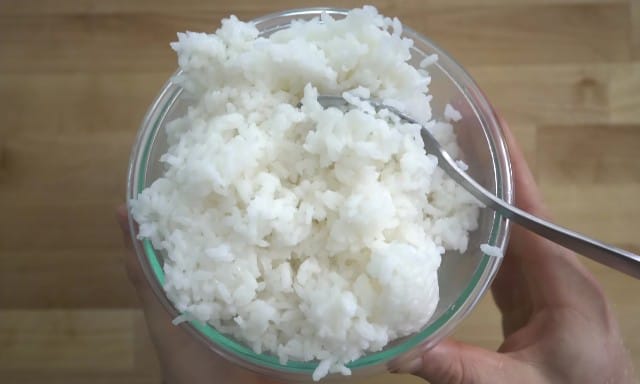
Cook the rice:
Boil the short-grain rice in water until sticky.
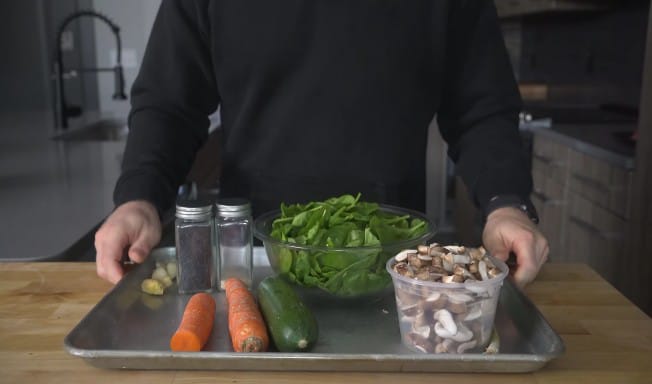
Prepare the vegetables:
Slice or cube the vegetables thinly.
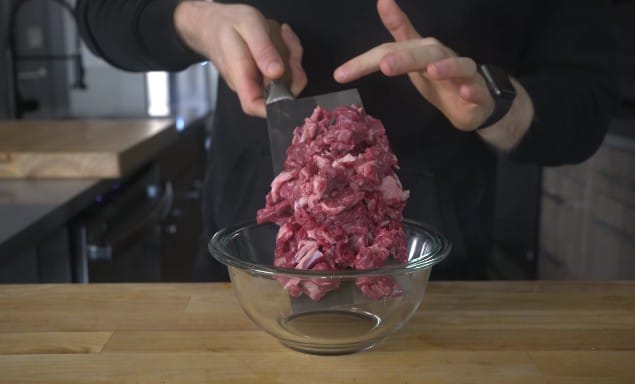
Cook the protein:
Slice the beef or chicken thinly and stir-fry in sesame oil. For tofu, cube and stir-fry it in sesame oil.
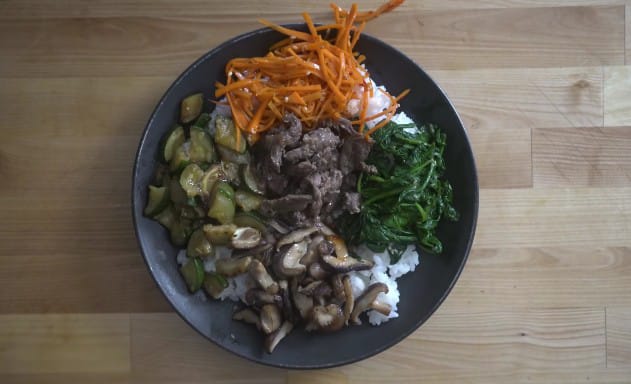
Mix all the ingredients:
In a hot stone bowl, add the cooked rice, sautéed vegetables, protein, egg, gochujang sauce, kimchi, and noodles (if using).
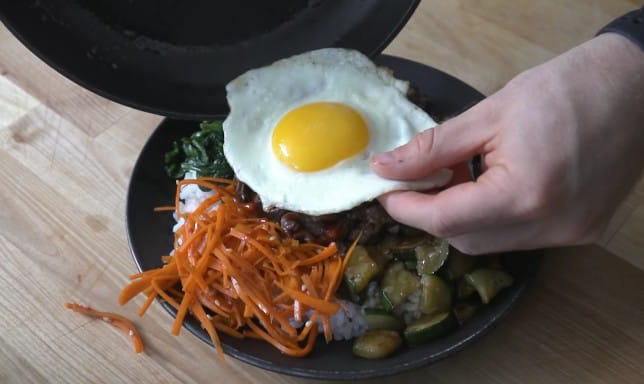
Fry the egg:
Heat a pan with a little oil and fry the egg lightly.
Stir well:
Mix all the ingredients thoroughly to blend the flavors.
"Bibimbap : A Step-by-Step Video Guide."
Tips for Enjoying Bibimbap
- Use ingredients you like: Customize with your favorite vegetables and protein.
- Adjust the gochujang sauce: If you like it spicy, add more sauce.
- Kimchi is optional: Skip it if you're not a fan.
- Use fresh vegetables: Fresh veggies make the dish tastier.
- Serve hot: Bibimbap is best enjoyed when served hot.
Health Benefits of Bibimbap:
- Rich in Vitamins and Minerals: The diverse vegetables in Bibimbap provide key nutrients like Vitamin A for eye health, Vitamin C for immunity, and iron for proper blood circulation.
- High in Protein: The inclusion of meat, tofu, or eggs makes it a good source of protein, which helps in muscle repair and maintenance.
- Supports Digestive Health: The fiber from the vegetables and kimchi aids digestion and promotes gut health.
- Balanced Energy Source: The carbohydrates from rice offer sustained energy, making it a filling and satisfying meal.
- Promotes Heart Health: The healthy fats from sesame oil contribute to cardiovascular health.
Bibimbap Nutritional Benefits
| Nutrient | Per Serving (Approximate) |
| Calories | 300-400 kcal |
| Protein | 20-25 g |
| Carbohydrates | 50-60 g |
| Fats | 8-12 g |
| Fiber | 4-6 g |
| Vitamin A | 30-40% of daily value (DV) |
| Vitamin C | 25-35% of DV |
| Vitamin K | 15-20% of DV |
| B-Vitamins | 10-15% of DV |
| Iron | 10-12% of DV |
| Calcium | 8-10% of DV |
| Magnesium | 12-15% of DV |
| Antioxidants | High, depending on vegetables |
"You’ve learned how to make and enjoy bibimbap, but did you know there’s so much variety in this dish? Let’s take a look at some interesting facts about bibimbap."
Details Calories in Bibimbap Dish Click Here
Different Types of Gochujang Sauce
Gochujang sauce is the heart and soul of bibimbap. This Korean chili paste gives the dish its red color and spicy flavor. There are many types of gochujang sauces available, varying in heat and flavor:
- Regular Gochujang: The most common type with a medium level of spice.
- Sweet Gochujang: Contains less chili and has added sugar for a sweeter taste.
- Spicy Gochujang: Ideal for those who like their food extra spicy.
- Honey Gochujang: Infused with honey for a sweet and spicy flavor.
You can choose any type of gochujang sauce to suit your taste.
Dishes Served with Bibimbap
Bibimbap is often served alongside other Korean dishes. Some popular options include:
- Kimchi: A fermented cabbage dish that adds a tangy flavor.
- Sundubu Jjigae: A spicy tofu soup.
- Gukbap: A thin beef broth soup.
- Banchan: Small side dishes like kimchi, seaweed salad, and sesame seeds.
Suggestions for Making Bibimbap
- Use fresh vegetables for better taste.
- Adjust the amount of gochujang sauce based on your spice preference.
- Serve hot for the best experience.
- Feel free to customize the dish with your choice of vegetables and protein.
Bibimbap's Popularity Across Cultures
Bibimbap is not only famous in Korea but has gained popularity worldwide. Many countries have bibimbap restaurants, and people love to make it at home. Its appeal lies in its delicious flavor and health benefits.
Frequently Asked Questions About Bibimbap
- What is Bibimbap?
- Bibimbap is a Korean dish made by mixing rice with various vegetables, meat or tofu, a fried egg, and gochujang sauce, typically served in a hot stone bowl.
2. How is Bibimbap made?
- To make bibimbap, cook the rice, sauté the vegetables, stir-fry the meat or tofu, fry an egg, and mix all the ingredients together in a bowl with gochujang sauce.
3. What is served with Bibimbap?
- Bibimbap is often served with kimchi, gukbap, and banchan.
4. Is Bibimbap vegetarian?
- Yes, bibimbap can be made vegetarian by omitting meat and using tofu instead.
5. Is Bibimbap spicy?
- Yes, bibimbap can be spicy due to the gochujang sauce, but you can adjust the spice level by using less sauce.
6. Can I make Bibimbap at home?
- Yes, bibimbap is easy to make at home by gathering the necessary ingredients and following the steps.
7. Is Bibimbap healthy?
- Yes, bibimbap is a healthy dish as it includes various vegetables, protein, and carbohydrates.
8. Do kids enjoy Bibimbap?
- Yes, bibimbap is popular with kids because it’s colorful and delicious. You can reduce the gochujang sauce for a milder version.
9. Can I replace the meat in Bibimbap?
- Yes, tofu can be used as a meat substitute in bibimbap.
10. How long does it take to make Bibimbap?
- Bibimbap takes around 30 minutes to prepare.
Meal, offering a rich combination of essential vitamins, minerals, proteins, and carbohydrates. It is particularly high in antioxidants, promoting good health by fighting free radicals.
Conclusion:
Bibimbap is a colorful, healthy, and customizable Korean dish that offers an array of health benefits. It's a perfect combination of nutrition and flavor, which can easily be made at home. Whether you're a fan of spicy foods or prefer milder flavors, you can adjust the Bibimbap to suit your taste while still enjoying its vast array of health benefits.
GET IN TOUCH
Try it today and experience the vibrant flavors of Korea in your own kitchen!
"Discover your new favorite recipe." Click here
Recipe Card
Bibimbap is a popular and delicious Korean dish that’s not only tasty but also visually appealing.
- • Rice: (Short- grain rice is the best as it’s sticky and binds all the ingredients well.)
- • Vegetables: (You can use any vegetables of your choice like carrots, cucumber, beans, cabbage, mushrooms, spinach, etc.)
- • Protein: (You can use beef, chicken, or tofu. Vegetarians can opt for tofu.)
- • Egg: (A fresh egg.)
- • Gochujang Sauce: (This Korean chili paste gives bibimbap its red color and spicy flavor.)
- • Sesame Oil: (Adds an amazing aroma to the dish.)
- • Kimchi: (A fermented cabbage dish that adds a tangy flavor (optional))
- • Noodles: (You can add noodles if you like.)
- 1. Cook the rice
- Boil the short-grain rice in water until sticky.
- 2. Prepare the vegetables:
- Slice or cube the vegetables thinly.
- 3. Cook the protein:
- Slice the beef or chicken thinly and stir-fry in sesame oil. For tofu, cube and stir-fry it in sesame oil.
- 4. Mix all the ingredients:
- In a hot stone bowl, add the cooked rice, sautéed vegetables, protein, egg, gochujang sauce, kimchi, and noodles (if using).
- 5. Fry the egg:
- Heat a pan with a little oil and fry the egg lightly.
- 6. Stir well:
- Mix all the ingredients thoroughly to blend the flavors.
Servings 2
- Amount Per Serving
- Calories 400kcal
- % Daily Value *
- Total Fat 12g19%
- Total Carbohydrate 60g20%
- Dietary Fiber 6g24%
- Protein 25g50%
- Vitamin A 40 IU
- Vitamin C 35 mg
- Calcium 10 mg
- Iron 10 mg
* Percent Daily Values are based on a 2,000 calorie diet. Your daily value may be higher or lower depending on your calorie needs.
Suggestions for Making Bibimbap
- Use fresh vegetables for better taste.
- Adjust the amount of gochujang sauce based on your spice preference.
- Serve hot for the best experience.
- Feel free to customize the dish with your choice of vegetables and protein.
THANK YOU
 Hi, I'm Sagar Rakshit, a food blogger based in India. I'm happily married and have the joy of sharing my life with my amazing family. My passion lies in exploring different cuisines, creating delicious recipes, and sharing my culinary adventures with you all.
Hi, I'm Sagar Rakshit, a food blogger based in India. I'm happily married and have the joy of sharing my life with my amazing family. My passion lies in exploring different cuisines, creating delicious recipes, and sharing my culinary adventures with you all.



